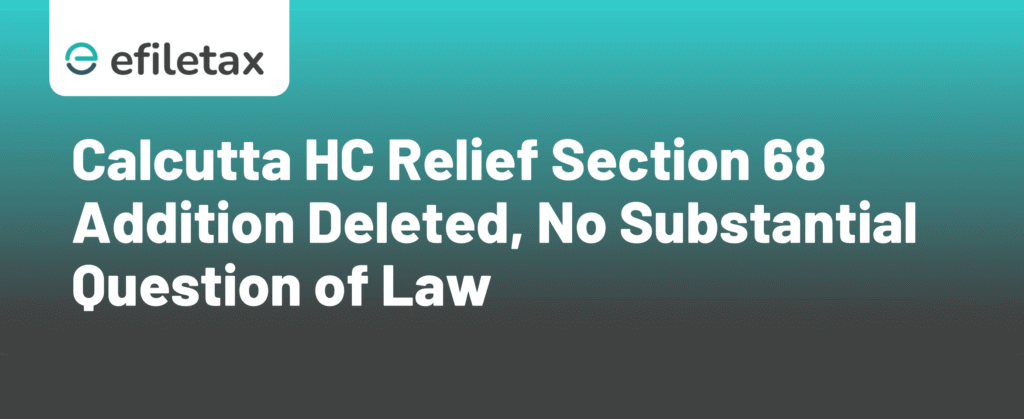
Section 68 Share Capital Addition: What Calcutta HC’s Ruling Means for Taxpayers
The Calcutta High Court recently dismissed the Income Tax Department’s appeal against an ITAT order that deleted a share capital addition under Section 68 of the Income-tax Act, 1961. This decision reaffirms judicial consistency in cases where the assessee has discharged its onus.
Let’s simplify what this ruling means and how it can help businesses facing similar scrutiny.
What is Section 68 of the Income-tax Act?
Section 68 empowers the Assessing Officer to treat unexplained cash credits as income. In share capital cases, this often becomes a tool to challenge transactions lacking proper documentation.
Key points under Section 68:
- Applies to cash credits, including share capital, share premium, loans
- Assessee must explain the nature and source of credit
- If unsatisfactory, the amount can be taxed as income
Case Summary: Calcutta HC Dismisses Revenue’s Appeal
Citation: 2025 TAXSCAN (HC) 1375
- The assessee had received share capital and premium
- Filed complete documents: PANs, confirmations, bank statements of investors
- AO made addition under Section 68 alleging accommodation entries
- CIT(A) and ITAT both ruled in favour of assessee
- Calcutta High Court found no substantial question of law
Court’s Observation:
Once the assessee establishes the identity, genuineness, and creditworthiness of the investor, the burden shifts to the Revenue.
Legal Angle: When is Addition Under Section 68 Invalid?
Courts have consistently held that mere suspicion or doubt isn’t enough.
Landmark Case Laws:
- CIT vs. Lovely Exports (P) Ltd [(2008) 216 CTR 195 (SC)]: Identity of shareholders proved—no addition
- Pr. CIT vs. NRA Iron & Steel Pvt. Ltd [(2019) 103 taxmann.com 48 (SC)]: Genuineness and creditworthiness are essential
In the Calcutta HC case:
✔ Identity – PAN & ROC records provided
✔ Genuineness – Bank entries traced
✔ Creditworthiness – Investors’ financials submitted
No material contradiction found by the department. Hence, the addition was rightly deleted.
Practical Impact for Indian Businesses
This ruling gives relief in genuine capital raising cases.
What you should do:
- Maintain investor KYC and financials
- Record board resolutions and share application money receipts
- Use banking channels for all capital inflows
- Cross-verify investor filings with MCA
Expert Tip:
👉 Always keep soft and hard copies of proof ready. Most additions arise from poor paperwork, not faulty transactions.
Share Capital vs Loan under Section 68
| Particulars | Share Capital | Unsecured Loan |
|---|---|---|
| Proof Required | PAN, bank proof, ROC data | PAN, bank proof, ITR of lender |
| Additional Checks | Allotment records, Form SH-7 | Loan agreement, interest trail |
| Easier to Defend? | Yes, if company is active | Harder due to repayment doubts |
FAQs
Q1. Does PAN alone prove identity?
Not always. PAN + bank + ITR or ROC filings help establish credibility.
Q2. Can AO still question share capital after IT return is processed?
Yes, during scrutiny assessments or search, especially if large premium involved.
Q3. What if investor doesn’t respond to AO?
If initial documents are on record and no contradiction is shown, assessee can’t be penalised for third-party non-response.
Final Word
The Calcutta High Court’s dismissal of the Revenue appeal reinforces a settled principle: tax cannot be levied based on assumptions.
If you’ve complied with documentation and investor tracing, additions under Section 68 may not stand judicial scrutiny.
Need help preparing documentation or responding to income tax notices?
Talk to Efiletax experts – We help startups, private companies, and small businesses navigate income tax complexities with ease.
Summary
Calcutta HC dismissed an appeal against ITAT’s deletion of a Section 68 share capital addition, ruling in favour of the assessee. Once identity and creditworthiness are proven, the burden shifts to the Revenue. Genuine taxpayers with proper documents have a strong legal ground.